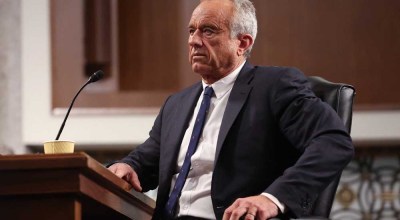Report raises concerns about Oregon’s health insurance exchange
Published 12:00 am Wednesday, April 24, 2019

- A nurse takes a blood pressure reading. (Whitten Sabbatini/The New York Times file photo)
Rising health costs and disruptive policy changes by the Trump administration have increased health insurance premiums and destabilized Oregon’s health insurance marketplace, according to a report issued by a consumer advocacy group last week.
The report, from OSPIRG Foundation and Frontier Group, warned that Oregon’s health insurance exchange created under the Affordable Care Act is beginning to show cracks and that without steps to stabilize it, the market could collapse.
“We’re not necessarily expecting that to happen in the next year or two, but there’s that risk,” said Mark Griffith, a health care advocate with OSPIRG. “It wouldn’t take a lot of disruption to get us to the point where things are potentially destabilizing.”
The exchange is threatened by rising premiums, which are discouraging healthy, middle-class people from buying coverage. The average monthly premium for the second-cheapest silver level plan on the Oregon exchange rose to $443 in 2019, nearly double what it was in 2014. Most Oregonians purchasing exchange plans, however, are shielded from those premium increases because they received subsidies from the federal government.
On average, a 40-year-old nonsmoker living in Portland would pay just $209 for a silver plan after subsidies. Subsidies cut out above $49,460 for an individual or $103,000 for a family of four.
“They’re not getting subsidies, but they’re still not making that much money,” Griffith said. “They’re facing these very, very high premiums.”
Only about 5% of Oregonians purchase their own health coverage, including 3.7% who purchase plans through the exchange. Prior to the ACA, however, many of those consumers couldn’t get insurance due to preexisting conditions, and plans offered limited coverage with annual and lifetime caps on benefits that left many insured patients facing hefty medical bills. The ACA eliminated many of those problems, but that raised the average price of a policy.
The report chronicled a number of reasons why premiums were rising on the exchange, including a 9% average increase in 2019. Health care is getting more expensive, the authors wrote, due to increases in both health care prices and the amount of services provided to patients. The total average cost of health insurance, whether paid by an employer or an employee, now accounts for more than 30% of median household incomes. That’s double what the rate was in 1990.
Premiums have also been rising due to direct action by Congress and the Trump administration, according to the study authors. Lawmakers eliminated the penalty for not having insurance, reduced outreach and marketing that convinced people to purchase plans, ended payments to insurance plans to reduce their risk and cut off payments to plans that covered their cost of serving low-income customers.
Those changes resulted in fewer healthy people buying insurance, spreading the cost of sicker customers over a smaller group of people. Health plans have had to increase premiums to compensate.
“I think what we’ve seen is that the marketplace that currently exists is a lot more stable than we expected in the absence of an insurance mandate. And that’s because the population that’s being covered is different from what we originally expected,” Griffith said. “Pretty much everybody who’s still on the marketplace is subsidized. The population that is not subsidized, for the most part, they’re not buying insurance.”
Oregon state officials declined to comment on the report, but the findings echoed previous statements from Insurance Commissioner Andrew Stolfi. Last year, in announcing the final premiums for 2019, Stolfi said that changes on the federal level “continue to inject instability into our market” and that Oregon had taken steps to reverse some of the rate increases caused those changes.
The authors suggested a number of steps Oregon could take to stabilize the marketplace. Other states have passed their own individual mandate and collected a penalty for not having insurance coverage. If Oregon were to adopt an individual mandate, it could generate $70 million to $80 million in new revenue that could be used to provide subsidies to more people, and would serve to increase the number of people insured and lower premiums.
A number of Oregon insurance plans indicated they increased premiums specifically because of the repeal of the individual mandate.
The authors suggested Oregon could also consider creating a public plan to be sold on the exchange. That would provide another option for those living in counties with few choices. New Mexico recently studied the possibility of offering a Medicaid buy-in option, finding that premiums would be 15% to 28% lower than for private plans. But offering a public plan could put additional pressure on commercial plans, prompting some of them to leave the individual market, the report said.
Another option proposed in the report included expanding the reinsurance program in Oregon, through which the state picks up part of the tab for high-cost enrollees. Oregon could also stop using the federal online platform, HealthCare.gov, and run its own exchange. The state has been exploring the cost of doing so, but may still be smarting from a botched rollout of its own exchange in 2014. In 2018, Oregon health plans had to pay $16 million in fees to use the federal exchange, and that rate is expected to rise to $25 million to $30 million in 2019. Those fees ultimately were paid by consumers through higher premiums.
— Reporter: 541-633-2162, mhawryluk@bendbulletin.com






